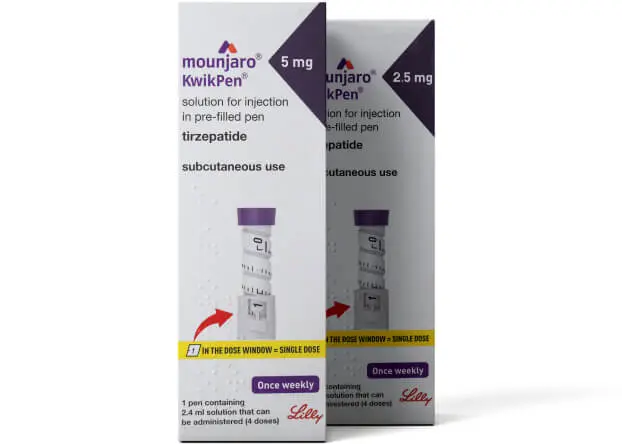
Mounjaro
Mounjaro is a once-weekly injection administered under the skin, including the abdomen, thigh, or upper arm. It is most often prescribed to improve blood-sugar control in adults with type 2 diabetes and to support weight management. People commonly report reduced appetite and smoother glucose levels when used alongside a balanced diet and regular exercise. To find out if it’s the right treatment for you, click on the ‘Start Consultation’ link below and follow the prompts.
Mounjaro 2.5mg | 1 KwikPen (4 injections) | €449 | |
|---|---|---|---|
Mounjaro 5 mg | 1 KwikPen (4 injections) | €449 | |
Mounjaro 7.5mg | 1 KwikPen (4 injections) | €579 | |
Mounjaro 10mg | 1 KwikPen (4 injections) | €579 |
What you need to know about Mounjaro.
Tirzepatide activates GIP and GLP‑1 receptors, helping regulate appetite, slow gastric emptying, and improve insulin secretion and sensitivity. This supports weight reduction and blood glucose control.
It is licensed in the UK for type 2 diabetes. Some UK services also prescribe it for weight management in eligible adults; availability and criteria follow current NICE/MHRA guidance.
As a once‑weekly subcutaneous injection (abdomen, thigh, or upper arm), on the same day each week. Rotate injection sites.
Typical titration: 2.5 mg weekly for 4 weeks, then 5 mg weekly. If needed, increase by 2.5 mg every 4 weeks (e.g., 7.5, 10, 12.5, up to 15 mg) as directed.
Nausea, vomiting, diarrhoea or constipation, abdominal pain, decreased appetite, reflux, fatigue. Serious: pancreatitis (severe abdominal pain), gallbladder problems, dehydration, possible worsening of diabetic retinopathy with rapid glucose improvement, and rare allergic reactions.
Moderate alcohol may worsen stomach side effects and can increase hypoglycaemia risk if you also use insulin or sulfonylureas. Limit alcohol and monitor your symptoms.
Compared with GLP‑1‑only medicines (e.g., semaglutide, liraglutide), tirzepatide often shows greater average weight loss and glucose lowering in trials, but GI effects are similar. Choice depends on suitability, access, and prescriber advice.
GI intolerance, pancreatitis, gallstones, dehydration, and hypoglycaemia when combined with insulin/sulfonylureas. Not for type 1 diabetes or diabetic ketoacidosis. Avoid in pregnancy and during breastfeeding.
No major drug‑drug interactions are typical, but it can slow stomach emptying and may affect absorption of some oral medicines. If on insulin/sulfonylureas, dose reductions may be needed to prevent hypos.
See the Patient Information Leaflet, NHS and NICE guidance, and ask your prescriber or pharmacist.
